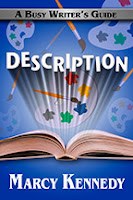Part of the Indie Author Series
Over the past few months, we’ve been talking about advertising our books because one of the biggest hurdles we have to overcome as indie authors is discoverability. Readers can’t buy and enjoy our books unless they know they exist.
I know that talking numbers and marketing isn’t fun for a lot of writers, but I’m so glad you’re sticking with me. Successful indie authors are also successful business people.
If you haven’t read all the previous posts in this series, I recommend you start from the beginning. We’ve already looked at a big picture overview of when and what we might want to advertise, and we talked about whether there’s ever a time when it’s okay to lose money on advertising.
Then I threw you into the math deep-end because we needed to figure out whether we’re earning or losing money on our ads and how read-through affects our investment.
This month we’re finally moving on to one of the different options available to us for advertising—newsletter ads.
Understanding Newsletter Ad Sites
Readers sign up for free to newsletter sites to be notified—usually daily—about free, discounted, or newly released books, depending on the site.
Some of these readers are bargain hunters or freebie seekers who won’t ever go on to buy a full-priced book. Most of them, however, are readers who are looking for a low-risk way to try new-to-them authors. With how glutted the ebook market is now, it can be really hard for readers to find books they’ll enjoy. If they’re avid readers, it can also get expensive.
When I was first considering purchasing ad slots from the newsletter sites, what convinced me was my own buying habits. I’d been burned by new authors too many times, and so I was already using these sites to help me try new authors out before I paid full price for any of their books. I’d go on to read whole series and backlists once I found an author I enjoyed.
In order to get a spot in one of these newsletters, we’ll normally have to discount our books to either free or 99 cents (or have a book that’s permanently free).
Each newsletter will also have quality requirements. Some of these are standard like having a professional looking cover and a book that’s free of grammatical errors. Others also require a certain number of reviews. For the most competitive sites, we’ll be asked to “sell ourselves,” telling them about awards or anything else that sets us and our book apart.
We’ll also need to provide our own ad copy. This isn’t ad copy the way we normally think of it, though. It means they’ll want book descriptions of various lengths meant to hook readers and entice them to click.
And even if we meet their requirements, a spot still isn’t guaranteed. These slots are becoming more and more competitive all the time as the indie author community grows.
As soon as someone throws requirements at us, it’s human nature to think it must be a good idea to try to meet those requirements and get a spot. That might not be true.
Before we hand over our money to buy a newsletter ad slot, we need to vet them as well to make sure each newsletter is a good use of our money.
Is their list genre-specific? Do they divide their newsletter list by interest?
The best return on investment usually comes from lists that target a single genre area (e.g., Book Barbarian for fantasy and science fiction vs. Book Adrenaline for mystery and thrillers) or segment their list. Segmented newsletters allow readers to select which genres they’re interested in when they sign up.
Most readers aren’t omnivores who’ll read anything and everything. We all have preferences. I’ll read mysteries, science fiction, and fantasy, but I won’t read military fiction or erotica. If I received a newsletter filled with those latter two genres, the authors would have wasted their money. They’re never going to make a sale from me.
Do their prices scale based on how many readers are interested in a particular genre?
A newsletter with 20,000 people interested in our genre shouldn’t be charging us the same amount to advertise as a newsletter with 200,000 subscribers.
The only way you’ll be able to judge this is by looking at multiple sites so you have an idea of what’s average. A site whose pricing is slightly higher than the norm shouldn’t be crossed off our list immediately because they might have a more engaged subscriber base, but we should consider carefully before buying a slot and track our results to see if they deliver on that higher cost.
Have other authors in your genre successfully advertised with this newsletter?
A great way to avoid bad experiences is to ask others for advice. If you’re in a Facebook group with other authors in your genre, ask what sites have worked well for them. That’s the best place to start.
Are they open about the average number of free downloads or sales people receive?
Be wary of anyone who guarantees a certain number of downloads or sales. That can be a sign that they’re doing something unethical to guarantee those numbers. Those aren’t the kinds of sites we want to buy ads from. Setting aside the ethical concerns, we aren’t gaining readers if the site we bought the ad from is inflating our download numbers somehow.
That said, a newsletter site should be upfront about the average number of downloads people see. Average means they aren’t guaranteeing anything, but this is about what you can expect, all other things being equal.
Do you have any newsletter sites you’d like to recommend other authors try? Or any other tips about newsletter advertising? If so, please share them in the comments!
 Marcy Kennedy is a mystery and speculative fiction writer who believes fantasy is more real than you think. Alongside her own writing, Marcy works as a freelance fiction editor and teaches classes on craft and social media. She’s also the author of the Busy Writer’s Guides series of books. You can find her blogging about writing and about the place where real life meets science fiction, fantasy, and myth at marcykennedy.com.
Marcy Kennedy is a mystery and speculative fiction writer who believes fantasy is more real than you think. Alongside her own writing, Marcy works as a freelance fiction editor and teaches classes on craft and social media. She’s also the author of the Busy Writer’s Guides series of books. You can find her blogging about writing and about the place where real life meets science fiction, fantasy, and myth at marcykennedy.com. Blog | Facebook | Twitter | Amazon | Apple iBooks | Barnes & Noble
About Description
 Description in fiction shouldn’t be boring for the reader or for the writer.
Description in fiction shouldn’t be boring for the reader or for the writer. Description: A Busy Writer’s Guide will help you take your writing to the next level by exchanging ho-hum description for description that’s compelling and will bring your story to life, regardless of the genre you write.
In Description: A Busy Writer’s Guide, you will
- find the answer to the age-old question of how much description is too much;
- learn how to use point of view to keep description fresh;
- recognize the red flags for boring description in fiction;
- explore how to use all five senses to bring your descriptions to life for the reader;
- discover the ways metaphors and similes can add power to your descriptive writing;
- gain the tools needed to describe setting, characters, and action in engaging ways;
- learn how descriptions can add conflict, enhance the theme, and amp up emotion; and
- much more.


I've been hesitant to buy ads and your input really helps. Thank you so much!
ReplyDeleteI've had my best luck with genre specific newsletter ads and newsletters that have a wider base but segment their readers. This still isn't foolproof. A newsletter may cover your genre but ads in it may not turn a profit. You have to test.
ReplyDelete